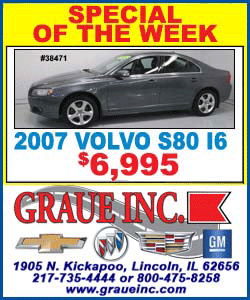|
A climate problem even California can't
fix: tailpipe pollution
 Send a link to a friend
Send a link to a friend
 [February 01, 2019]
By Nichola Groom [February 01, 2019]
By Nichola Groom
LOS ANGELES (Reuters) - For three decades,
California has led the fight to control tailpipe pollution, with
countless policies promoting cleaner gasoline, carpooling, public
transportation and its signature strategy - the electric vehicle.
Californians now buy more than half of all EVs sold in the United
States, and the state’s auto-pollution policies have provided a model
being adopted around the world.
But they’re not working at home, by the state’s own measure. Tailpipe
pollution here is going up, not down, despite billions of dollars spent
by one of the most environmentally progressive governments on earth.
"The strategies that we've used up until now just haven't been
effective," Mary Nichols, the head of the California Air Resources
Board, told Reuters.
That failure has less to do with energy or environmental policies and
more with decades-old urban planning decisions that made California –
and especially Los Angeles – a haven for sprawling development of
single-family homes and long commutes, according to state officials.

California’s struggle bodes poorly for other major U.S. cities with
similar sprawl and expensive urban housing – such as Houston, Atlanta,
and others that planned their cities around cars - and casts doubt on
whether the United States can meet its pledged carbon cuts under an
international agreement to fight climate change.
The state's troubles also hold lessons for massive economies including
China and India, major carbon emitters that hope to control pollution
from vehicles as they rapidly urbanize.
Transportation is tied with power generation as America’s leading source
of carbon dioxide emissions, at 28 percent, according to the U.S.
Environmental Protection Agency – and it takes top billing in
California, at about 40 percent. It makes up a smaller share in the rest
of the world, where car ownership is lower but likely to grow.
California's carbon emissions amounted to 429 million metric tons in
2016, the last year for which data is available. That's the lowest level
since 1990 thanks to a shift away from coal-fired electricity toward
natural gas, solar and wind.
But its next target - calling for a further 40 percent cut by 2030 -
will be out of reach without transformative changes in state residents'
driving habits, CARB said in a report published late last year.
As the state struggles to cut its own vehicle pollution, California
officials are also fighting an effort by the administration of U.S.
President Donald Trump to weaken national standards for automobile
emissions. A spokesman for newly-elected Governor Gavin Newsom, who ran
on a promise to continue California's legacy of climate action, did not
return requests for comment.
A QUIET ADMISSION
California's tailpipe emissions have risen 5 percent since 2013,
according to CARB data, as population growth, urban sprawl, and a
devotion to one’s own car produced longer commutes and choking traffic.

The increase came even as the state has finally caught traction in
promoting electric and hybrid vehicles, some 1.18 million of which have
been sold in the state since 2011, according to the Alliance of
Automobile Manufacturers. The government last year set a target of 5
million electric vehicles by 2030.
But even hitting that goal – by no means assured - won’t be near enough
to allow the state to meet its goal for carbon reduction, which would
require California drivers to reduce per capita miles traveled by 25
percent, CARB said in its report.
The state has also boosted spending on public transport by about 60
percent over the past decade, according to CARB. But transit options are
poorly suited for California’s vast expanses of suburban-style
neighborhoods.
"If we keep thinking we are going to overcome a 1950s system overnight,
that's wrong," said Hasan Ikhrata, executive director of the San Diego
Association of Governments, the city's main public planning body.
SOARING EMISSIONS IN SPRAWLING U.S. CITIES
The United States has pledged to cut carbon emissions by between 26 to
28 percent from 2005 levels by 2030 under the Paris Agreement, an
international pact to fight climate change reached by nearly 200
countries in 2015.
While President Donald Trump has signaled his intention to pull the
United States out of the accord, a group of states led by California
wants to ensure the U.S. meets its commitments, which scientists call
critical to avoiding the most devastating effects of climate change.
[to top of second column]
|

Rush hour traffic moves north and south on interstate 5 near
Encinitas, California, U.S. October, 24, 2018. REUTERS/Mike Blake

But California's problems - and those of other sprawling U.S. cities
- suggest that meeting that goal will be difficult.
In Houston, for example, tailpipe emissions have soared 46 percent,
posing a major challenge for the city’s goal of becoming carbon
neutral by 2050.
Unlike California, Texas has no statewide greenhouse-gas reduction
goals, and the state’s love affair with gas-guzzling trucks is only
deepening. More than two thirds of new vehicles registered in the
Houston area last year were pickup trucks or SUVs, compared to less
than half in Los Angeles, according to IHS Markit, a global
financial information provider.
Electric cars, by comparison, represent just 1 percent of new
vehicle sales in Texas, according to the state's Department of Motor
Vehicles. In California, it was around 7 percent in the first eight
months of last year, according to data compiled by the Alliance of
Automobile Manufacturers.
Transportation emissions have also been rising in other major cities
such as Atlanta, Philadelphia, and San Antonio, according to city
climate emissions reports from recent years, and have climbed about
21 percent nationwide since 1990, according to the EPA.
FIGHTING POLLUTION WITH URBAN PLANNING
Other parts of the world could have an easier time.
In Europe, residents of densely populated cities face high fuel
taxes, encouraging reduced car travel. Many European cities have
seen relatively high levels of electric car adoption.
And in China and India, which also have lofty electric vehicle
targets, major cities are still being built - with pollution control
in mind.

“They are much better able to bake in this kind of planning into
their urban designs,” said John German, a senior fellow with the
non-profit International Council on Clean Transportation.
One example is China’s new zone of Xiongan, a spill-off district to
ease overcrowding in Beijing, which is being designed from scratch.
In a document published in January, the Chinese government promised
to incorporate low-carbon development ideas – such as high-speed
commuter rail and efficient land use - into its planning for Xiongan
to “create a convenient, safe, green and intelligent transportation
system”.
China is also seeking to improve fuel standards, ban old cars, and
stop diesel trucks from entering certain areas as car ownership
surges by about 20 million vehicles per year.
California officials, eager to maintain the state’s leadership role
on climate action, hope to pave the way for a fix to entrenched
urban sprawl.
Los Angeles is mulling a proposal to charge drivers during rush hour
and use that money to make public transit free by 2028, according to
Metro Chief Executive Phillip Washington.
Other options include waiving fees for pooled rides to and from
airports and adding safety lanes for scooters and bikes, said Dan
Sperling, director of the Institute of Transportation Studies at the
University of California, Davis.
CARB Deputy Executive Officer Kurt Karperos said the state is
planning talks with municipal governments to discuss controlling
emissions through city planning.
Such efforts could include lower-cost housing in urban centers to
bring people closer to work, and the elimination of building codes
requiring parking spots to encourage more drop-off carpooling,
according to experts.
"It is a tough problem," Karperos said.
(Editing by Richard Valdmanis and Brian Thevenot)
[© 2019 Thomson Reuters. All rights
reserved.]
Copyright 2019 Reuters. All rights reserved. This material may not be published,
broadcast, rewritten or redistributed.
Thompson Reuters is solely responsible for this content.
 |